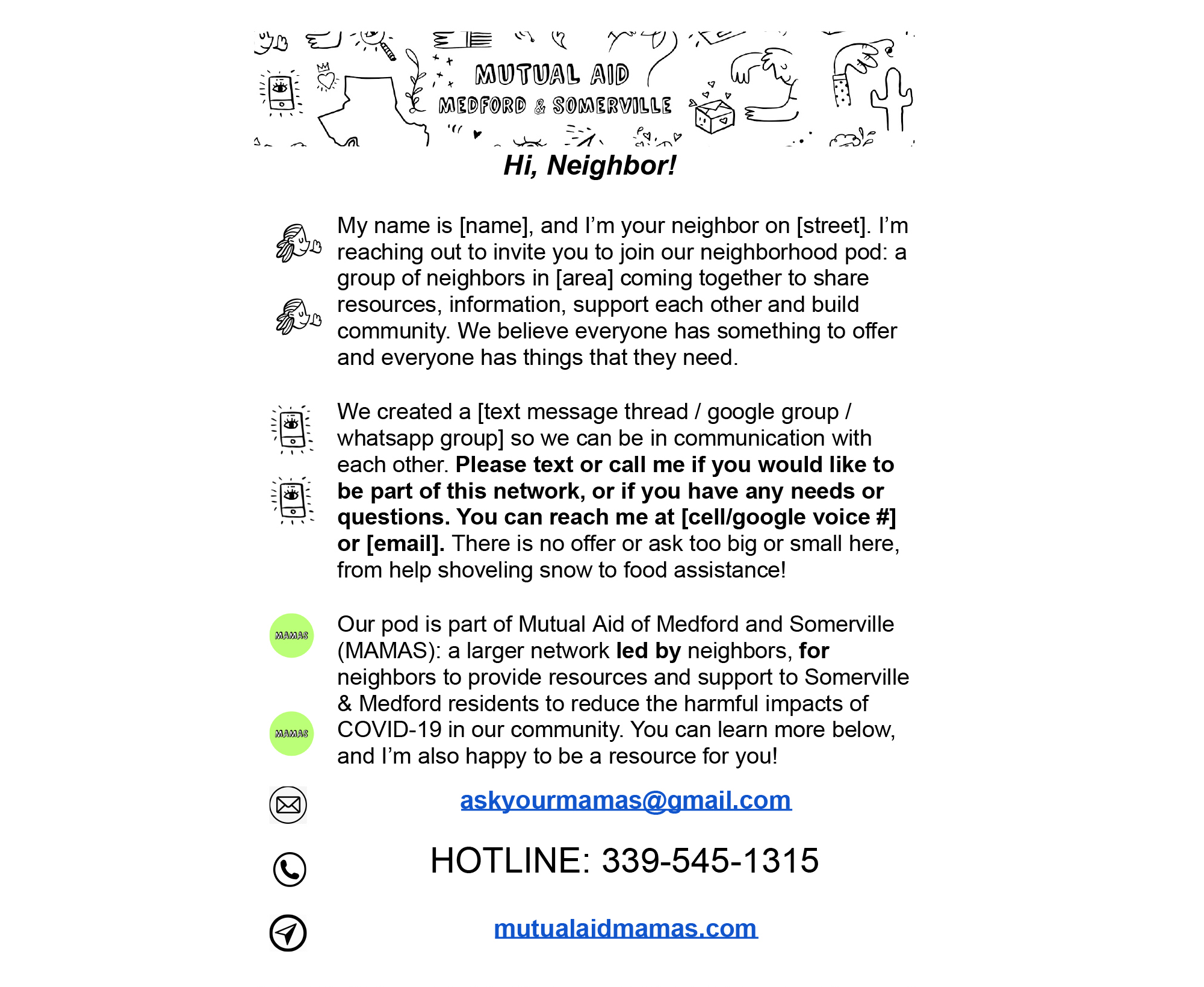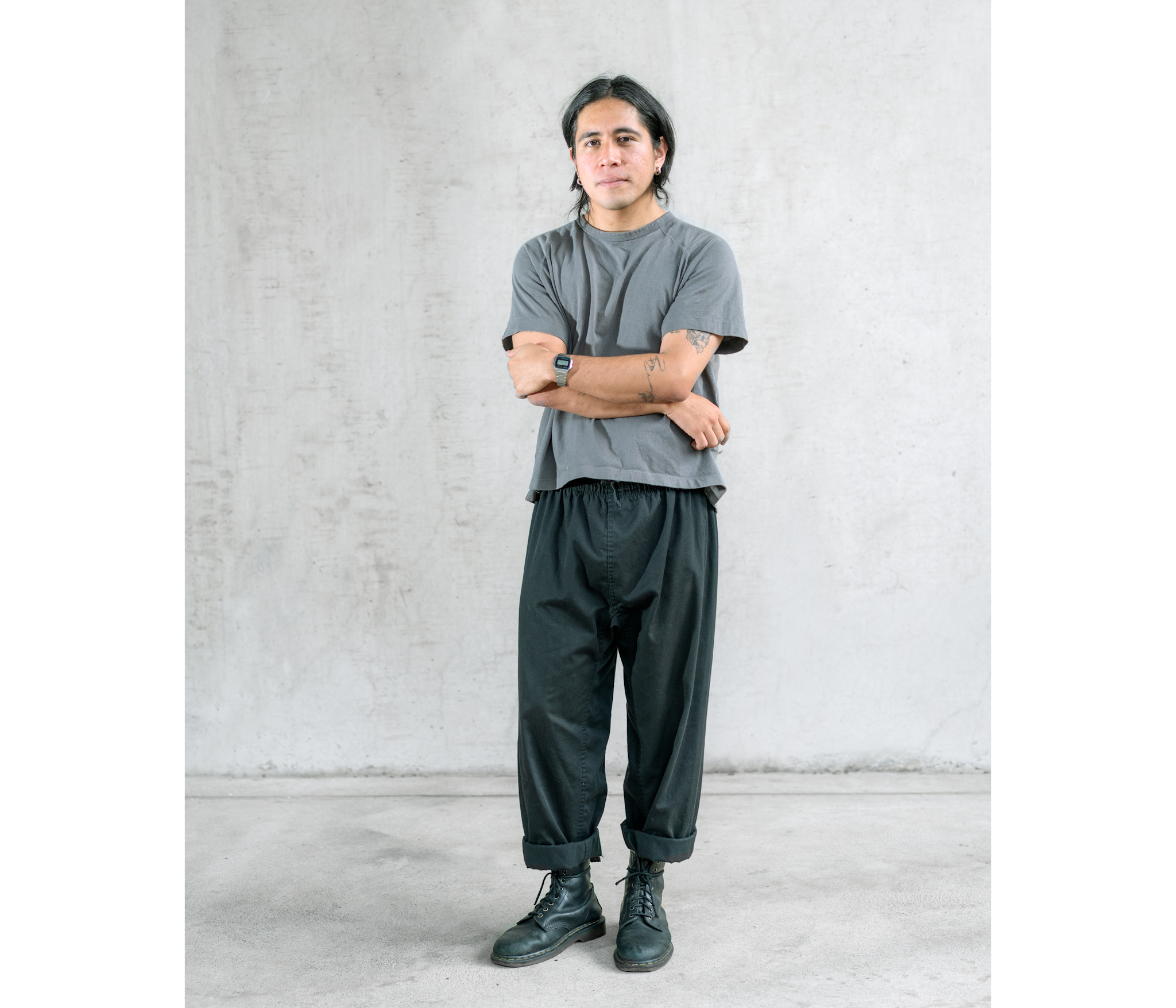Julie Cho (a graphic designer) and I (a social worker) publish books and booklets. We call ourselves Thick Press because our publications explore the thick, ongoing practices involved in care work and social movement work. In March of 2021, Mark Anthony Hernandez Motaghy, an artist and cultural worker who shares Thick Press’s interest in archiving the poetics and the pragmatics of care work, contacted us about collaborating on a print project.
Mark had become involved in food distribution and organizing with Crown Heights Mutual Aid (CHMA), a group of neighbors helping neighbors in response to the pandemic—and upon their move to the Boston area, Mark began to organize with a very similar group, Mutual Aid Medford and Somerville (MAMAS). Julie, Mark, and I weren’t sure what form the book should take, but in the spirit of mutual aid work, Mark knew that many voices should be involved, and thus began a series of conversations with mutual aid organizers from both Brooklyn and Somerville. About a year later, we risograph-printed the first 150 copies of Rehearsing Solidarity: Learning from Mutual Aid, which we sold at printing cost from Thick Press’s website.
In the midst of preparations to produce a second printing to disseminate at the New York and Boston art book fairs in October and November, we took a moment to reflect on the project.
Erin Segal: I would love to start by talking about how your organizing with CHMA and MAMAS led to a book. Where did it all start?
Mark Anthony Hernandez Motaghy: It didn’t really start in one place. Like I say in the book’s introduction, the project started in March of 2020 when I myself needed support, and also when I had a lot more time on my hands and could work with CHMA full-time. But another entryway into the project was when we made the “Care, Not Cops” poster for CHMA. That was in collaboration with designer Julia Schäfer. CHMA had been running for four months, and we wanted to do more flyering to continue to get the word out—but in this process we also wanted to communicate our ethos, which consisted of centering racial justice work, refusing to collaborate with law enforcement, pursuing political anti-racist education, and prioritizing Black and Brown community organization.
The poster design, for me, directly connects to the tone, form, and structure of the zine-book. For example, the word “Care” is spelled in a way where each letter is its own anthropomorphic character and, in a sense, has its own voice. That relates to the various voices transcribed in our publication and how we co-created this project. In contrast to “Care,” the typeface aesthetic for “Not Cops” tries to communicate how much of the work that CHMA is doing is necessitated by the violence and oppression carried out by police and the carceral apparatus. We thought of this poster as its own form of mutual aid, and we sold them and raised about a thousand dollars, which then went back into the community groceries.
ES: I had assumed that it all started with the writing.
MAHM: I started to feel confident that this could be a writing project after discussing my mutual aid organizing experience with essayist Garnette Cadogan. I took a class with him [at MIT] called The Fire Next Time, named after James Baldwin’s book, which explored writers contending with race and racism in American cities. In class, we discussed the dangers of relying on data to describe complex situations in cities. We studied writers who spoke from a subjective point of view first and then used data to reinforce the story. The section in the zine-book where I’m riding my bike from Crown Heights to Brownsville, thinking about the asymmetry of givers and receivers—that was already written from that class and I was able to rework that for the publication. I took a year off of school and I reached out to you because I had this text and I had some ideas for a collaboration with CHMA and MAMAS.

(left) Sketch for Crown Heights Mutual Aid plan for pods, 2020. Courtesy Mark Anthony Hernandez Motaghy. (right) Slide on the grocery intake process from CHMA’s Neighborhood pod-share presentation, 2021.Presented by Madeline Blount, Nedra Brown, and Amy Garapic from CHMA. Courtesy Mark Anthony Hernandez Motaghy.
ES: In addition to your writing, the zine-book contains interviews with other mutual aid organizers. Can you talk about the decision to include interviews—and why we decided to keep the full conversations?
MAHM: There are a few factors that led to this decision. At first, we just wanted to include snippets. The conversations were too “in the weeds.” Social reproduction done collectively can be riveting, but it can also be boring. After some back and forth on how digestible the interviews should be, we landed on keeping them and highlighting key moments within the conversations in blue.
MAMAS actually has a protocol where anytime someone from outside the organization wants to talk to MAMAS for an interview or get information, at least two organizers are a part of it. And that comes with an understanding that people have a partial reading of what’s happening in the group and they each might have their own interpretation of their work and interactions.
Including these voices also comes from thinking about how collective knowledge emerges from social struggles. In a broad sense, thinking about the difference between knowing with, and speaking amongst, rather than knowing about and speaking from a distance. If we understand knowledge production in that way, it was aspirational for me to think of the zine-book as an artifact we collectively produced. What if we could make an artifact that doesn’t have an author and instead has been authored? I know it doesn’t work that way, but that’s the dream.
ES: As part of the project, you hosted a public conversation, sponsored by the Urbano Project in Jamaica Plain, about pods, which are small groups of neighbors who rely on one another for resources like food. For that event, you brought together organizers from MAMAS and CHMA for the first time. One of the most powerful moments in the pod-share conversation was when MAMAS organizer Matt Taylor talked about how leaning into “moments of the whirlwind” sometimes requires pausing and stepping back once the whirlwind ceases. Can you explain that moment more? And how it connects to burnout?

Template for neighborhood pod flyering, 2021. Created by MAMAS Neighborhood Pod Persons Coordinators working group. Courtesy Mark Anthony Hernandez Motaghy.
MAHM: There was a collective exhale in the room when he said that. Matt was responding to CHMA stopping their hotline and grocery deliveries because of a lack of capacity. I believe Matt was trying to reframe burnout by saying, what if it’s natural that things end and perhaps restart in another way? At the time, everyone in that meeting from CHMA and MAMAS knew we were collectively moving past a rapid emergency response mode. Capacity was starting to fade, yet there were still so many needs that neighbors needed to have met.
I really appreciated this reframing. It felt like we were getting the capitalism out of us, out of our bodies. Burnout has such a negative connotation, as if formations aren’t supposed to burn out, as if things are supposed to sustain and grow forever and keep going. And instead of forcing this formation, he’s asking, what would it mean to be in alignment with the cycles and the temporalities of this work? Maybe it does sustain itself forever. Or maybe it wants to just take a rest and be something else.
ES: At the end of the book, you talk about some of your disillusionment with the term “care.” I’m wondering where you stand on that today.
MAHM: I was just so frustrated with the word “care” at that time. Me and my ex partner, who I went to school with, have a running joke where it’s like “Care™,” “Care, trademark” going around the institutions. I wasn’t disillusioned by care work itself, instead by the way it was being theorized, in both an uncritical and disembodied state within these elite institutional settings. I wanted to see more embodied practice and that wasn’t defanged from being anti-capitalist. I want to continue to question what is the work, because a lot of the times the theorizing gets posed as the work.
ES: Even though it’s separate from the “real” work of care, I think it’s important to document the ongoing caring practices that occur every day. Most people pay attention to damning critiques or hero stories. It rarely occurs to people to capture the ongoingness, but it definitely occurred to you! You put so much care into compiling the interviews and documenting your own process. So I guess I’m wondering, where does that come from—that compulsion to capture the stream of life?
MAHM: I had the compulsion to capture the stream of life in large part because I was undergoing psychoanalysis. At the onset of the pandemic, I was writing almost daily about care and maintenance, individually and collectively, in relation to myself. But as the project developed, it became critical to consider how I was documenting this. And once it was documented, what form would it take? How might this form and structure challenge the kind of savior narrative you mentioned? As we now know, it’s challenging to tell this story. There’s a reason the book’s structure is non-linear and why there are no easy answers or “red-pilled” takeaways. One of the main inspirations for how to tell this story was actually Ursula Le Guin’s “The Carrier Bag Theory of Fiction.”
ES: I was thinking about that exact text when I asked you that question, so we’re aligned!
MAHM: Amazing! I think of the Carrier Bag Theory as both a method and way of storytelling. In terms of storytelling—actually, Mindy Seu has a good essay on this—we can think of the first protagonist as a gatherer rather than the hunter, and what that means for the hero. What does it mean to go from “he singular to we plural”? We can also think of this basket as a methodological practice, like a slow gathering of material. If the spear is something that I have my eye set on, where I want this project to go, and where I think I should land, the basket is kind of like, let me see who and what’s around me. Let me see what’s sprouting near. Then you can slowly find what the story wants to be rather than impose a vision or throw the spear. I had all this stuff—some things poetic, some “useful”—and it remained fragmented, but I think it reads in a way where there are no savior-type heroes in the story. It’s a story about doing collective social reproductive labor, often mundane tasks done by everyday people, by a community coming together to fight back against state failures by meeting each other’s needs.

Mark Anthony Hernandez Motaghy in collaboration with Julia Schäfer. Crown Heights Mutual Aid Flyer, 2020.
ES: I’d love to end by asking, what are you taking away from this project, and what’s on the horizon for you?
MAHM: The various projects I’m working on feel like a garden. Right now, many seeds are planted, and it’s difficult to tell when projects will take root and potentially cross-pollinate. I’m still inspired by Madeline Blount’s sketch on Rehearsing Solidarity’s cover, with its “tech-location-based” network where neighborhood members can plug in to help meet each other’s needs. This sketch continues to bring forward questions of community technology, its intersection with the solidarity economy, and how communities could rehearse alternative socio-technical relationships. I have been conspiring with artists Xin Xin, Alice Yuan Zhang, and Max Fowler on what it would mean to have community-stewarded servers, who might maintain them, and how they might host local data with communal memory and information.
Our MAMAS Neighborhood Pod Coordinator meetings are on hold, but pods are still running autonomously. Several neighbors have been interested in getting our pod running again, which is exciting. Mutual aid organizing has slowed down, but it has led to further economic democracy work, such as becoming a fellow at Boston Ujima Project. I’m working on a publication project that supports Ujima in moving deeper into the cultural space to support artists and cultural organizers. My main collaborator, Cierra Peters, and I are questioning how we can make the practice of solidarity one that is, to borrow from Toni Cade Bambara, irresistible.
This interview was originally published in print in Issue 09: Burnout.




